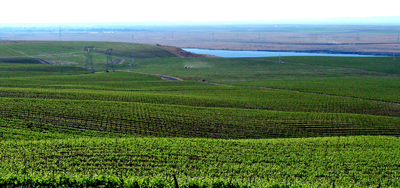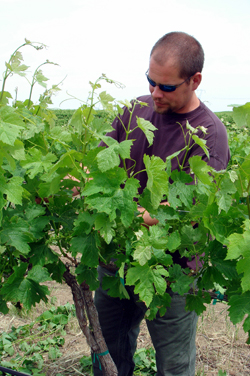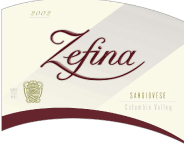

Alder Ridge is a sea of green: More than 800 acres of grapes at Alder Ridge Vineyard are cooled by the winds blowing up the Columbia River.
Cab May Be King, But at Zefina the Rhones Rule
At Corus Estates & Vineyards’ Alder Ridge Vineyard, noteworthy Rhone varieties grow side-by-side with Cabernet. Winemaker Rob Chowanietz talks about the unique grapes that go into Zefina Wines.
by
Anne Sampson
January 16, 2008
Anne Sampson (AS): You’re growing a lot of varieties here that most others don’t. What makes them work at Alder Ridge?
Rob Chowanietz (RC): The Rhones are unique in that we can get them ripe here. They’re very difficult to mature. We have a really long hang time here.
Winemaker Rob Chowanietz in the vineyard.People look at the amount of heat we get and they presume that we’re early, like Red Mountain. That’s not even close to the truth. We’re one of the latest sites in Eastern Washington.
We have that beautiful Columbia River, and that cools everything down. We get a 30-40 degree difference between day and night. And we don’t have very many heat spikes. We had maybe one week of over-100 degree heat all summer. Typically it’s in the mid to high 90s. We always have a nice breeze here. It blows across the vineyards, so it has a cooling effect. We pick our Cab in late October and the Rhone varieties in the last week of October. This year we finished harvesting on October 31, which is early. We typically finish November 3rd.
AS: Some of your wines tend to be on the high end of alcohol. Is that because you’re seeing high sugars after such a long ripening period?
RC: I guess the average sugars would be around 25 Brix. Grenache and Syrah, especially, tend to come in pretty high. It’s not a problem, but it’s something I’m actively working on. We’re constantly looking for something where we can get a little better balance with lower alcohol. We’re playing with the date of fermentations, different yeasts, different conversions to alcohol. We’re playing with crop load. We brought a few of our varieties down to two and a half tons per acre. That gave us a little bit earlier maturing, a little bit lower sugar. That helps bring the alcohol down, and I’m a big believer in that.
AS: There’s something of a debate going on right now about alcohol. Some people think we’re seeing more wines with high alcohol because the American public likes it.
RC: Well, that could be. My goal is more about balance. If you have a really bold wine and you can hold it at 15.5, almost 16 percent alcohol, then more power to you.
AS: That’s pretty powerful wine.
RC: Yes it is. I went to the annual Hospice du Rhone tasting in Paso Robles last year, and was blown away by some of the French Grenaches that were 16-plus, and they were light-bodied. It’s not just the U.S. that’s going to high alcohols. I was amazed by it. But still, I believe in bringing alcohols down, somewhere in the mid 14s, if you can find that balance.
AS: Are there other factors about this location that make Rhone varieties work here?
RC: Survivability is huge; hang time; and we have the ultimate ability to monitor water. In these sandy soils, you put water on it and it dives, dives, dives. There’s nothing holding the soil. There’s no clay. It’s a really low-vigor soil, and all that plays into letting us dial in the maturity. There is also the aspect of differing elevations. We come from 300 feet to almost 1000 feet, and we have lots of different exposures - southeast, northwest, we can really mix it up. Annual rainfall is somewhere around four inches a year. In the winter, we're covered with a blanket of fog, and that protects us. We have minimal bud damage at the very, very bottom of the vineyard, but we’ve never really been whacked by a real freeze, ever.
AS: There were several weeks of rains this fall. Was your crop affected?
RC: We were mostly in before we could be affected. But most storms here split before they cause damage. See this ridge back here? We can watch the clouds come up the river and then split to the left and the right. It can be raining at Champoux Vineyard or at Andrews, but it’s not doing anything here. And if it does rain here, an hour or two later the wind goes through and dries everything out.
AS: You’ve got a beautiful winemaking facility here right at the vineyard, which is somewhat unusual. Do you see any advantage in being able to crush on site?
RC: We don’t have to add as much sulfur, because we don’t have as much juicing. The trucks drop it off right here so if we have everything coordinated, we can be crushing while they’re picking. It’s off the vine into the fermenter, no sitting around in the heat, no trucking. The Zefina and Alder Ridge wines are all hand-picked, and we have the pickers sorting grapes, as well, so they’re much more careful in the vineyard. They understand the relationship. If they put anything in the bins, leaves or whatever, they’ll have to pull it out later.
AS: This is a huge vineyard, at 812 acres. How much of it is hand-picked?
RC: The entire orchard is about 40 percent hand picked and 60 percent machine, although that relationship is turning more and more to handpicked. More people are asking for it, because more are making $30 and $40 bottles of wine. The majority of the vineyard is 10 years old right now. As the vines are getting older, we’re seeing more premium quality on an annual basis. I think maybe the majority of this vineyard will be handpicked in 10 years.
AS: Zefina’s Serience blends are getting a lot of attention. Is there a particular direction you’re heading with them? Are you trying to emphasize a vineyard characteristic?
RC: Yes. It’s not what I would call wet stone, but it’s a cross between the earth and rock character in the vineyard. Almost all the varieties come in with a little of that aspect. I’m trying to emphasize that, but I’m really looking for across-the-palate balance between fruit, the acids, and the tannin structure. If something beautiful from the vineyard comes through, too, then we’re just that much better off.
Almost all the varieties come in with a little of that aspect. I’m trying to emphasize that, but I’m really looking for across-the-palate balance between fruit, the acids, and the tannin structure. If something beautiful from the vineyard comes through, too, then we’re just that much better off.
Photos by Jeanie Chowanietz
Rob Chowanietz (RC): The Rhones are unique in that we can get them ripe here. They’re very difficult to mature. We have a really long hang time here.

Winemaker Rob Chowanietz in the vineyard.
We have that beautiful Columbia River, and that cools everything down. We get a 30-40 degree difference between day and night. And we don’t have very many heat spikes. We had maybe one week of over-100 degree heat all summer. Typically it’s in the mid to high 90s. We always have a nice breeze here. It blows across the vineyards, so it has a cooling effect. We pick our Cab in late October and the Rhone varieties in the last week of October. This year we finished harvesting on October 31, which is early. We typically finish November 3rd.
AS: Some of your wines tend to be on the high end of alcohol. Is that because you’re seeing high sugars after such a long ripening period?
RC: I guess the average sugars would be around 25 Brix. Grenache and Syrah, especially, tend to come in pretty high. It’s not a problem, but it’s something I’m actively working on. We’re constantly looking for something where we can get a little better balance with lower alcohol. We’re playing with the date of fermentations, different yeasts, different conversions to alcohol. We’re playing with crop load. We brought a few of our varieties down to two and a half tons per acre. That gave us a little bit earlier maturing, a little bit lower sugar. That helps bring the alcohol down, and I’m a big believer in that.
AS: There’s something of a debate going on right now about alcohol. Some people think we’re seeing more wines with high alcohol because the American public likes it.
RC: Well, that could be. My goal is more about balance. If you have a really bold wine and you can hold it at 15.5, almost 16 percent alcohol, then more power to you.
AS: That’s pretty powerful wine.
RC: Yes it is. I went to the annual Hospice du Rhone tasting in Paso Robles last year, and was blown away by some of the French Grenaches that were 16-plus, and they were light-bodied. It’s not just the U.S. that’s going to high alcohols. I was amazed by it. But still, I believe in bringing alcohols down, somewhere in the mid 14s, if you can find that balance.
AS: Are there other factors about this location that make Rhone varieties work here?
RC: Survivability is huge; hang time; and we have the ultimate ability to monitor water. In these sandy soils, you put water on it and it dives, dives, dives. There’s nothing holding the soil. There’s no clay. It’s a really low-vigor soil, and all that plays into letting us dial in the maturity. There is also the aspect of differing elevations. We come from 300 feet to almost 1000 feet, and we have lots of different exposures - southeast, northwest, we can really mix it up. Annual rainfall is somewhere around four inches a year. In the winter, we're covered with a blanket of fog, and that protects us. We have minimal bud damage at the very, very bottom of the vineyard, but we’ve never really been whacked by a real freeze, ever.
AS: There were several weeks of rains this fall. Was your crop affected?
RC: We were mostly in before we could be affected. But most storms here split before they cause damage. See this ridge back here? We can watch the clouds come up the river and then split to the left and the right. It can be raining at Champoux Vineyard or at Andrews, but it’s not doing anything here. And if it does rain here, an hour or two later the wind goes through and dries everything out.
AS: You’ve got a beautiful winemaking facility here right at the vineyard, which is somewhat unusual. Do you see any advantage in being able to crush on site?
RC: We don’t have to add as much sulfur, because we don’t have as much juicing. The trucks drop it off right here so if we have everything coordinated, we can be crushing while they’re picking. It’s off the vine into the fermenter, no sitting around in the heat, no trucking. The Zefina and Alder Ridge wines are all hand-picked, and we have the pickers sorting grapes, as well, so they’re much more careful in the vineyard. They understand the relationship. If they put anything in the bins, leaves or whatever, they’ll have to pull it out later.
AS: This is a huge vineyard, at 812 acres. How much of it is hand-picked?
RC: The entire orchard is about 40 percent hand picked and 60 percent machine, although that relationship is turning more and more to handpicked. More people are asking for it, because more are making $30 and $40 bottles of wine. The majority of the vineyard is 10 years old right now. As the vines are getting older, we’re seeing more premium quality on an annual basis. I think maybe the majority of this vineyard will be handpicked in 10 years.
AS: Zefina’s Serience blends are getting a lot of attention. Is there a particular direction you’re heading with them? Are you trying to emphasize a vineyard characteristic?
RC: Yes. It’s not what I would call wet stone, but it’s a cross between the earth and rock character in the vineyard.
 Almost all the varieties come in with a little of that aspect. I’m trying to emphasize that, but I’m really looking for across-the-palate balance between fruit, the acids, and the tannin structure. If something beautiful from the vineyard comes through, too, then we’re just that much better off.
Almost all the varieties come in with a little of that aspect. I’m trying to emphasize that, but I’m really looking for across-the-palate balance between fruit, the acids, and the tannin structure. If something beautiful from the vineyard comes through, too, then we’re just that much better off.
Photos by Jeanie Chowanietz










 intense climate. Sandy soils and an average of 3,000 heat units per year also contribute. But the biggest factor might be the wind. Howling through the river corridor and whipping the face of the slopes above, the
intense climate. Sandy soils and an average of 3,000 heat units per year also contribute. But the biggest factor might be the wind. Howling through the river corridor and whipping the face of the slopes above, the  READER FEEDBACK: To post your comments on this story,
READER FEEDBACK: To post your comments on this story,


